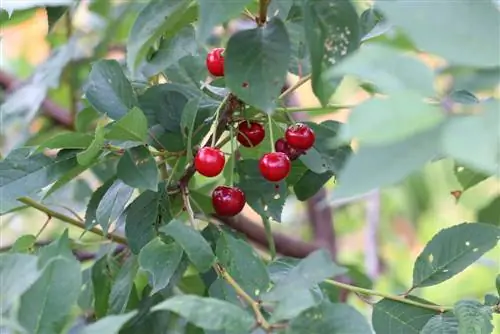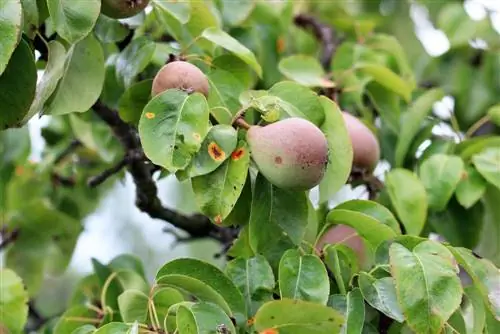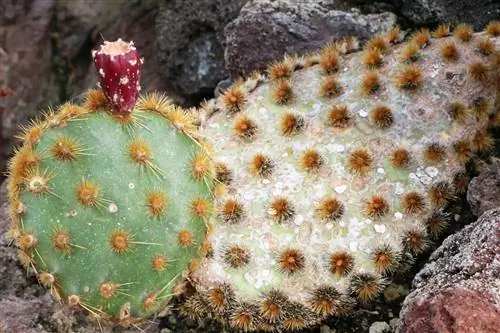- Author admin [email protected].
- Public 2023-12-17 03:39.
- Last modified 2025-06-01 06:48.
Pears taste delicious and are sweet. That's why many hobby gardeners have a pear tree in their garden or are planning to buy one. However, planting and care are not that easy. Pear trees are sensitive.
They need an ideal location and must be constantly checked for diseases and pests.
Plants
It is good if the location is somewhat shady. However, the tree should not have too little sun, otherwise the pears will not develop their full aroma. A warm, sheltered place is ideal. Deep soil is important. Soil fertilized with manure is also suitable. Plant substrate that is too acidic must be limed. If the soil is too moist, drainage is useful so that excess water can drain away.
The soil must be free of weeds. The planting hole should be slightly larger than the root ball of the pear tree. A post is inserted into the hole to support the pear tree. The tree is placed straight into the planting hole and at the same depth as before. The roots are spread out a little. Damaged parts are carefully cut off with clean scissors. Now topsoil is filled in and pressed down again and again until the hole is well filled. Finally, the earth has to be trampled really hard. The pear tree is tied to the support post with a ribbon. It is important to water the tree well. Until it has grown properly, it needs to be watered regularly.
In unfavorable locations, only selected, less sensitive pear varieties are planted, which are particularly well-equipped against late frosts. It is important that mulching is carried out all year round. It needs to be fertilized because the nutrient requirements are high. Regular additions of compost are recommended.
The first cut
The first cut takes place from mid-February. The branches on which the shoots for the pears arise, the leading branches, are cut back to about a third of their length. The cut is made approx. 1 cm above an outward-facing bud. The target of the cut is a terraced pear tree. All branches that are not used to build the crown are cut off 1 cm above the fork in the first year. Secondary branches are shortened by half. The branches on these are cut back to 1 cm.
Summer cut
In the summer, only the shoots that grew this year are cut back to a length of 10 cm. If the tree only bears small amounts of fruit or no fruit at all, the number of flowers should be reduced by cutting them off.
Annual cut
Regular pruning promotes tree growth and flowering. The central shoot is cut back. It should only protrude beyond the elongated side shoots by about a scissor length. The tree must be trained to have a wide crown. The crown diameter can be up to 8 meters and beyond. The main shoots are shortened, paying attention to broad cultivation! If necessary, the shoots must be staked, tied down or weighed down. The crowns must always be cut so that they are flooded with light. If necessary, the crown can be relieved by thinning it. To prevent aging, a sharp cut is recommended every now and then.
Topiary
If there is a lack of space or for better garden design, pear trees can also be grown like climbing plants on a house wall or on a trellis. It doesn't produce much fruit, but it looks good.
Diseases
Pear trees are sensitive to numerous pests and diseases. The most common is the pear grid. It is shown by orange spots on the leaves. There are no resistant pear trees yet. As a preventative measure, you should not plant juniper species nearby; they serve as intermediate hosts. If the infestation is severe, complex spraying is required, which must be repeated several times. If the infestation is small, you don't have to do anything.
- Pear leaf sucker - this type of flea overwinters as an insect in the bark. The eggs are laid in the tips of the shoots. The larvae excrete honeydew, which then develops into sooty mold, which affects all parts of the plant. Anything affected must be cut off and destroyed. A coat of bark reduces the possibility of overwintering. Predatory bugs decimate the flea population.
- Pear gall midge - the maggots bore into the fruit. To combat it, pick and destroy fruits in June/July. If this is not possible, collect and destroy fruit every day! Otherwise, maggots migrate into the soil, pupate and spin there, and the cycle begins again in spring.
- Boron deficiency - occurs frequently. It is shown by deformed and wrinkled fruits. The pulp is woody. Most of the time the tree does not bloom or the leaves become yellow and brittle. Shoot tips die off. If there is a real boron deficiency, spread approx. 10 g of borax per square meter and water thoroughly.
- Firebrand - is reportable. Caused by the bacterium Erwinia amylovora. The pathogen usually establishes itself permanently if the appropriate climatic conditions are met and appropriate host plants are available. All affected plant parts must be consistently removed. Plant protection products are not permitted.
- Monilia - is a fungus that overwinters on the tree and is spread to the flower stigmas in spring, especially when there is rain and wind. The fungus clogs the branches' pathways and leaves and flowers turn brown. The fruits can also be affected. The fungus is usually caused by an injury to the pear tree. The fungus is combated using copper products, which are, however, prohibited in gardens.






